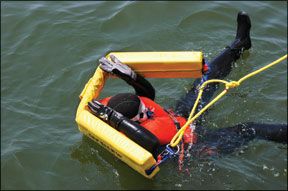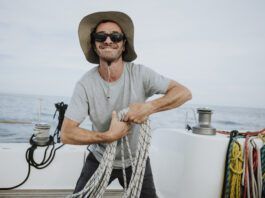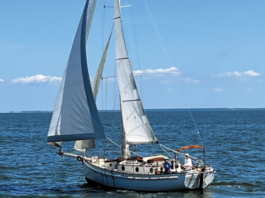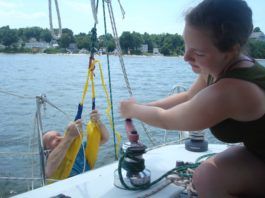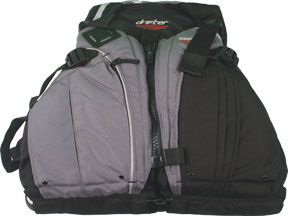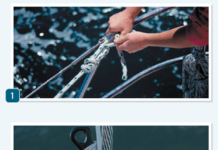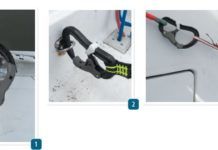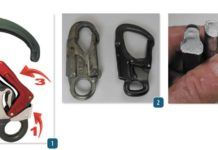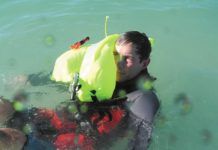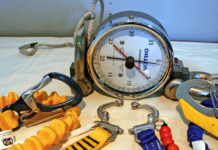Horseshoe and Ring Buoy Mounts for PFDs
The December, 1993, issue contained an in-the-water test and evaluation of 16 different Type IV life preservers (cushions, horseshoes and ring buoys). Besides their throwability, flotation and the ease with which a person in the water can get to and utilize them, an important consideration was said to be how quickly these Coast Guard-required "throwables" can be detached from the boat and made available to the man overboard. …
Chest High Jacklines
Jacklines (also called jackstays) are rigged along the deck on either side or down the centerline. This is where you are supposed to clip your safety tether.
The Pros and Cons of Chest-high Jacklines
World sailing offers fairly explicit expectations regarding jackstays. And PS offer its own additional advice, including one that recommends jacklines ideally be installed so that a sailor who is clipped in can't go over the side (see Jackline Installation Advice, November 2015). This is not always possible, especially on monohulls. In most cases, he chest-high lifeline on Mahina Tiare will keep above water the head of the person who is overboard.
Safety Tether Caution
The hallmark of an overboard fall protection system is a system of jacklines running along the deck, with tethers attached so that the sailor can move throughout the boat with relative freedom. But this is not the real backbone of the system. A review of overboard accidents reveals that very few fall when transiting from cockpit to bow-they get washed overboard when they stop to perform a task. While moving, sailors are focused, holding on with two hands, and mindful of the approach of waves and the motion of the boat. But while taming a headsail or straightening up a tangle of line in the cockpit, the mind wanders, the hands are occupied, and risk increases. A wave strikes, we tangle our feet or step on a sail, and whoosh . . . were overboard.
When is it Time to Retire a Safety Tether?
Rules of thumb are rather useless when it comes to equipment that is stored in a locker and then used roughly. Weve broken lots of new and old equipment during testing and learned a lot about what to look for, but even so we are often surprised when good looking equipment fails and scratched up stuff works fine. Inspect closely and often, regardless of age.
Safety Tethers Under Scrutiny
On November 18, 2017, Simon Speirs, an experienced sailor, went overboard while at the bow assisting with a headsail change on a Clipper Round the World Boat CV30. It was blustery, with sustained winds of 20 knots, gusting to 40 knots. Shortly after he went overboard, his safety tether detached and he was separated from his boat. His body was recovered 34 minutes later. The cause of death has not been determined but drowning is the suspected cause. While such accidents are tragic, they offer a chance to re-evaluate equipment standards within a real-world context.
Time to Review Tether Regs
Like a car seatbelt, the snap hook on a sailors safety tether has only one essential job to do. It must support the dynamic loads of a human body should a sailor fall overboard or get thrown across the deck to the end of his tether (about six feet). But late last year, when British sailor Simon Speirs was swept overboard during the Clipper Ventures Round the World Race, the resulting load bent and opened the stainless-steel snap hook that connected him to the 70-foot racing yacht CV-30.
New Trends in Sailing Safety Gear
Safety at sea has become more than a noteworthy slogan. Many feel it defines the right game plan and gear choice to ensure a favorable outcome in challenging conditions. But at Practical Sailor, we also recognize its role in incident prevention, and we understand why ones boat handling ability, navigation competency, weather awareness, and sound decision-making are just as important as the gear in the grab bag-perhaps even more so.
Tether Failure Cited in Fatality
Just as we were wrapping up the report in our December issue describing how to make your own safety tether, 60-year-old British sailor Simon Speirs went overboard and died during the Clipper Around the World Race in an accident linked to tether failure. The race, which charges non-professional sailors to race with pro skippers, was already under scrutiny after two deaths in the previous running.
Requirements for Pressure-testing Life Rafts
I have read several articles about life-raft inspections, but no article has stated how long a raft should be inflated to check for leaks during inspection. Do you have any idea?































